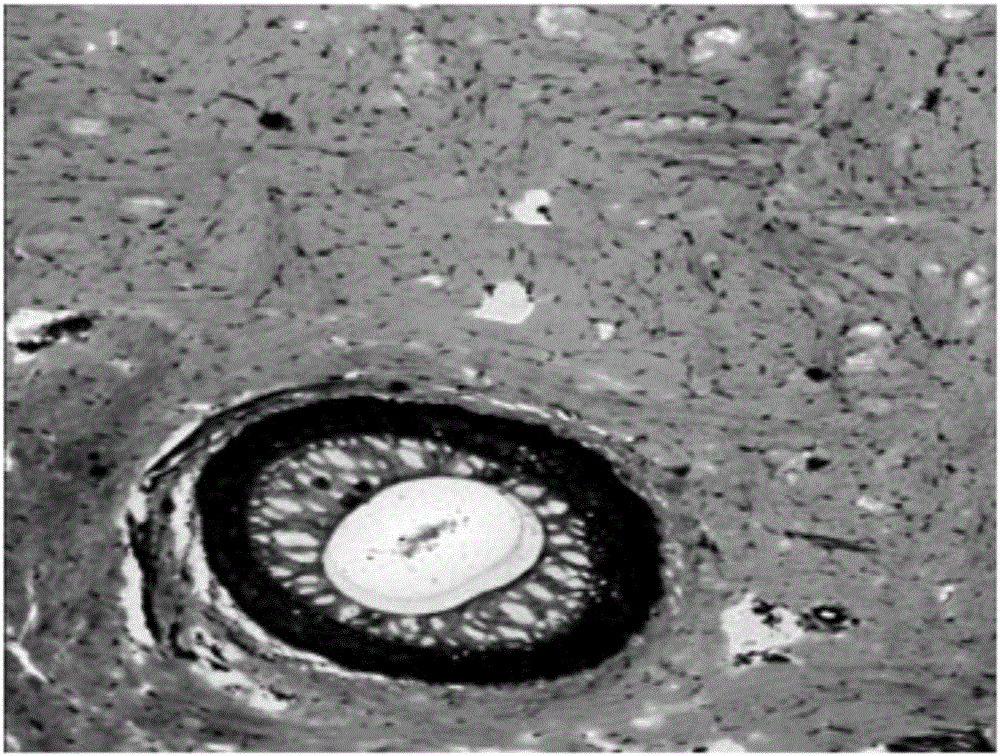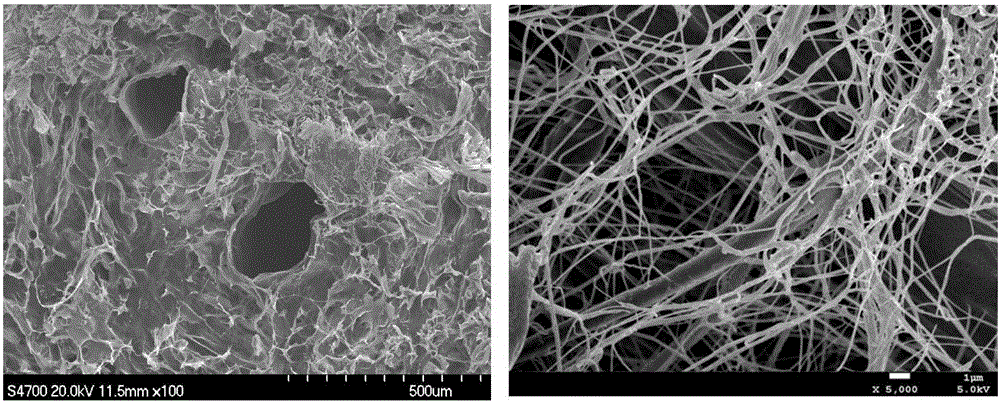Biological scaffold material suitable for cell growth and preparation method of biological scaffold material
A bio-scaffold and cell technology, applied in the field of bio-scaffold materials and its preparation, can solve problems such as insufficient purity, excessive collagen hydrolysis, and incomplete cell removal, and achieve safe and reliable raw materials, easy industrial production, and good cell compatibility Effect
- Summary
- Abstract
- Description
- Claims
- Application Information
AI Technical Summary
Problems solved by technology
Method used
Image
Examples
Embodiment 1
[0047] (1) Sectioning: select the back of fresh pigskin, use a sectioning machine to section, remove the subcutaneous fat tissue of the pigskin, and section the dermis to a thickness of 0.4-0.8mm.
[0048] (2) Water immersion: Weigh 100 parts by weight of animal hide and put it into the drum, add 300 times the volume of purified water, add 4 parts by weight of sodium chloride, rotate for 60-120min, add 50 parts by volume of 95% alcohol , soaked overnight.
[0049] (3) Chemical degreasing: put the washed animal skin into a drum, add 1 part by weight of Pingpingjia, add 1 part by weight of sodium carbonate, and treat at room temperature for 120 minutes. After washing with water, repeat for the second degreasing.
[0050] (4) Alkali erosion-surfactant combination method decellularization: add 1 weight part of sodium hydroxide, 3 weight parts of Pingpingjia, and 300 weight parts of purified water in the drum, and transfer the degreased animal skin to the drum. Drum, rotate 120mi...
Embodiment 2
[0055] (1) Sectioning: select the back of fresh pigskin, use a sectioning machine to section, remove the subcutaneous fat tissue of the pigskin, and section the dermis to a thickness of 0.4-0.8mm.
[0056] (2) Soak in water: take 100 parts by weight of animal hide and put it into the drum, add 400 parts by volume of purified water, add 5 parts by weight of sodium chloride, rotate for 60-120min, add 95% alcohol of 50 parts by volume, Soak overnight.
[0057] (3) Chemical degreasing: put the washed animal skin into a drum, add 2 parts by weight of Pingpingjia, add 1 part by weight of sodium carbonate, and treat at room temperature for 120 minutes. After washing with water, repeat for the second degreasing.
[0058] (4) Alkali erosion-surfactant combination method decellularization: add 1.5 parts by weight of sodium hydroxide, 2 parts by weight of Pingjiao, and 400 parts by weight of purified water in the drum, and transfer the degreased animal skin to the drum. Drum, rotate 12...
Embodiment 3
[0063] (1) Sectioning: select the back of fresh pigskin, use a sectioning machine to section, remove the subcutaneous fat tissue of the pigskin, and section the dermis to a thickness of 0.4-0.8mm.
[0064] (2) Soak in water: take by weighing 100 parts by weight of animal skin and put it into a drum, add 500 parts by volume of purified water, add 10 parts by weight of sodium chloride, rotate for 60-120min, add 95% alcohol of 50 parts by volume, Soak overnight.
[0065] (3) Chemical degreasing: put the washed animal skin into the drum, add 1 part by weight of Pingpingjia, add 2 parts by weight of sodium carbonate, and treat at room temperature for 120 minutes. After washing with water, repeat for the second degreasing.
[0066] (4) Alkali erosion-surfactant combination method decellularization: add 3 parts by weight of potassium hydroxide, 1 part by weight of TritonX-100, purified water of 500 parts by weight in the drum, and transfer the degreased animal skin into the drum, R...
PUM
 Login to View More
Login to View More Abstract
Description
Claims
Application Information
 Login to View More
Login to View More - R&D
- Intellectual Property
- Life Sciences
- Materials
- Tech Scout
- Unparalleled Data Quality
- Higher Quality Content
- 60% Fewer Hallucinations
Browse by: Latest US Patents, China's latest patents, Technical Efficacy Thesaurus, Application Domain, Technology Topic, Popular Technical Reports.
© 2025 PatSnap. All rights reserved.Legal|Privacy policy|Modern Slavery Act Transparency Statement|Sitemap|About US| Contact US: help@patsnap.com



